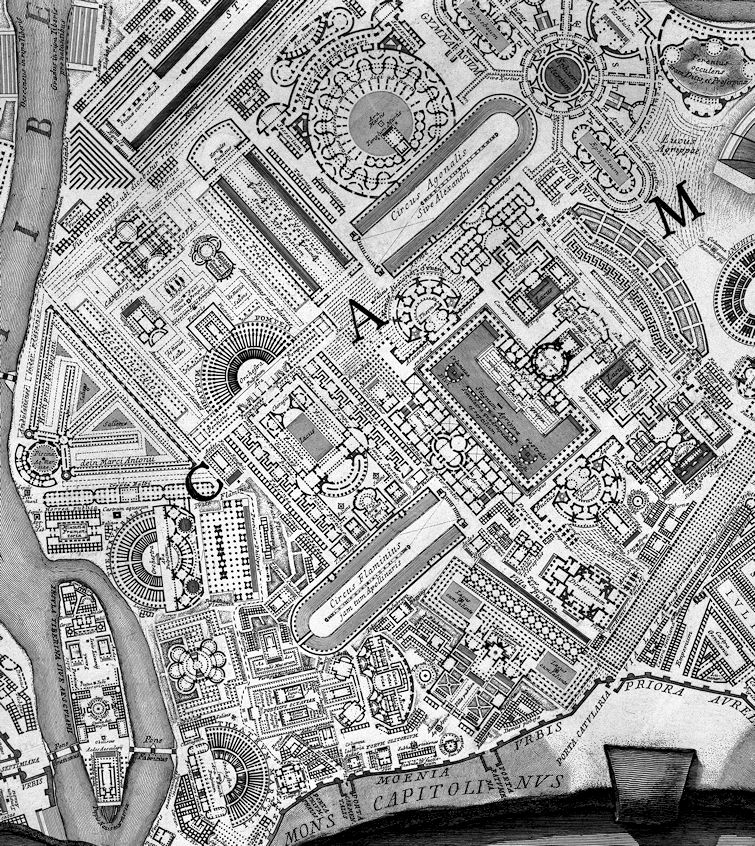Inside the Density of G. B. Piranesi's Ichnographia Campus Martius
density 1 : the quality or state of being dense : closeness of texture or consistancy : a crowded condidtion 2 b : the average number of individuals or units per space unit [3 : extreme stupidity]
At its maximum extent in the 3rd century A.D. the city came to occupy the whole area within the Aurelian Wall, an area of 4 sq.mi. (10 sq.km.) with a population variously calculated at 800,000 to 1,2000,000.
J. B. Ward-Perkins, "Rome," in Encyclopedia Britannica (Chicago: Encyclopedia Britannica, Inc., 1969), vol. 19, p. 565.
The Ichnographia Campus Martius comprises at least 500 individual building plans; some building are minute and nameless, while others are enormous conglomerates labeled with fitting Latin titles. Within the texts and the indices that accompany the Ichnographia, and hence compose the entire Campo Marzio publication, Piranesi cites no less than 312 existing ruins or ancient artifacts relative to the Campo Marzio and, likewise, gathers historical evidence from over 1000 literary sources culled from the works of more than thirty-five ancient and contemporary authors.
To Piranesi's credit, the densest portion of the Ichnographia, namely the lower left corner of the plan which corresponds more or less directly with the actual Campus Martius proper, is also the area within the Ichnographia that contains the highest degree of veracity. Piranesi's rendition of the area between the Pantheon, the Capitoline Hill and the Tiber in effect correctly places all the buildings that once stood in this region of the city. Granted, the individual building plans are archaeological distortions, however, Piranesi's overall arrangement of this particular area remains among the more actual "reconstructions" of the Campus Martius up until the end of the nineteenth century.
Although the notion of finding truth in density cannot necessarily claim the status of a universal dictum, it is nonetheless an affirmation that holds true for the Ichnographia Campus Martius.
| |

| |
1999.11.29 19:14
solid melt (pumpkin pie)
Hello Kelly,
I am happy to have met you at Inside Density, even though we did not speak with each other for any length of time. I have, however, already spoken about (here at home) your delicious pumpkin pie. I also just read your 'All that is solid melts into air' essay in A Moving City. I like the essay a lot; you establish a framework of urban analysis that is 'extremely' fecund. Two things immediately came to my mind while reading your essay, and I hereby share them with you.
1. I live just a few blocks from the world's largest (building) implosion site--the 31 October 1994 implosion of the Sears complex on Roosevelt Blvd. in Philadelphia. I enjoy telling people that Quondam, the first virtual museum of architecture, originates near the site of the world's biggest implosion.
2. The following is an email I sent very early this year to a design email list here in the States. In fact, I also sent this email to archipol@archis.com, and it was through that channel and this email that I found out about Inside Density. You and I say the same thing about Vinh, Vietnam and Berlin respectively:
city making and city breaking
It has not escaped my attention that Operation Desert Fox has spurred some discussion here within the design-list that very much resembles the notion of humanity presently working metabolically, i.e., equal doses of creation and destruction. With regard to what I last said here concerning the possible notion of an assimilating architecture, my further elaboration of there presently also being an imaginative operation of a metabolic nature now seems very timely. I thus wish to interject one example of metabolic architecture/urbanism.
Berlin: foremost metabolic city of the 20th century
No doubt the city of Berlin, Germany has undergone unequaled metamorphosis throughout the course of the 20th century. [Kelly, your essay now well informs me that Berlin's metabolic process this century is indeed matched by Vinh.]
Berlin reached one of this planet's highest levels of urban density within the first quarter of this century.
In the 1930s, Berlin became capital of the National Socialists Third Reich, an unprecedented create/destroy political machine, extreme even in its assimilation, the Holocaust purge.
1945, the Battle of Berlin leaves the city all but totally destroyed.
During the Cold War, Berlin increasingly becomes a very real duality, a duality much like metabolism itself.
1989, the Berlin Wall opens, falls, and within a few years the city is again united.
Y2K, Berlin begins the 21st century as a completely new German capital.
The pattern of creation and destruction completely pervades the last 100 years of Berlin's history, but then again it is also the capital of one of the 20th century's foremost metabolic nations.
Berlin and Germany are not alone in their metabolism, however. One only has to look at Japan and its two A-bomb cities, the two Koreas, the once two Vietnams, and there is always Israel and Old Jerusalem.
No one has yet suggested the likelihood of two Iraq's and/or two Bagdads, but it wouldn't surprise me in the least if that place somehow became very metabolic as well.
I sincerely hope we somehow continue a dialogue along metabolic lines.
|